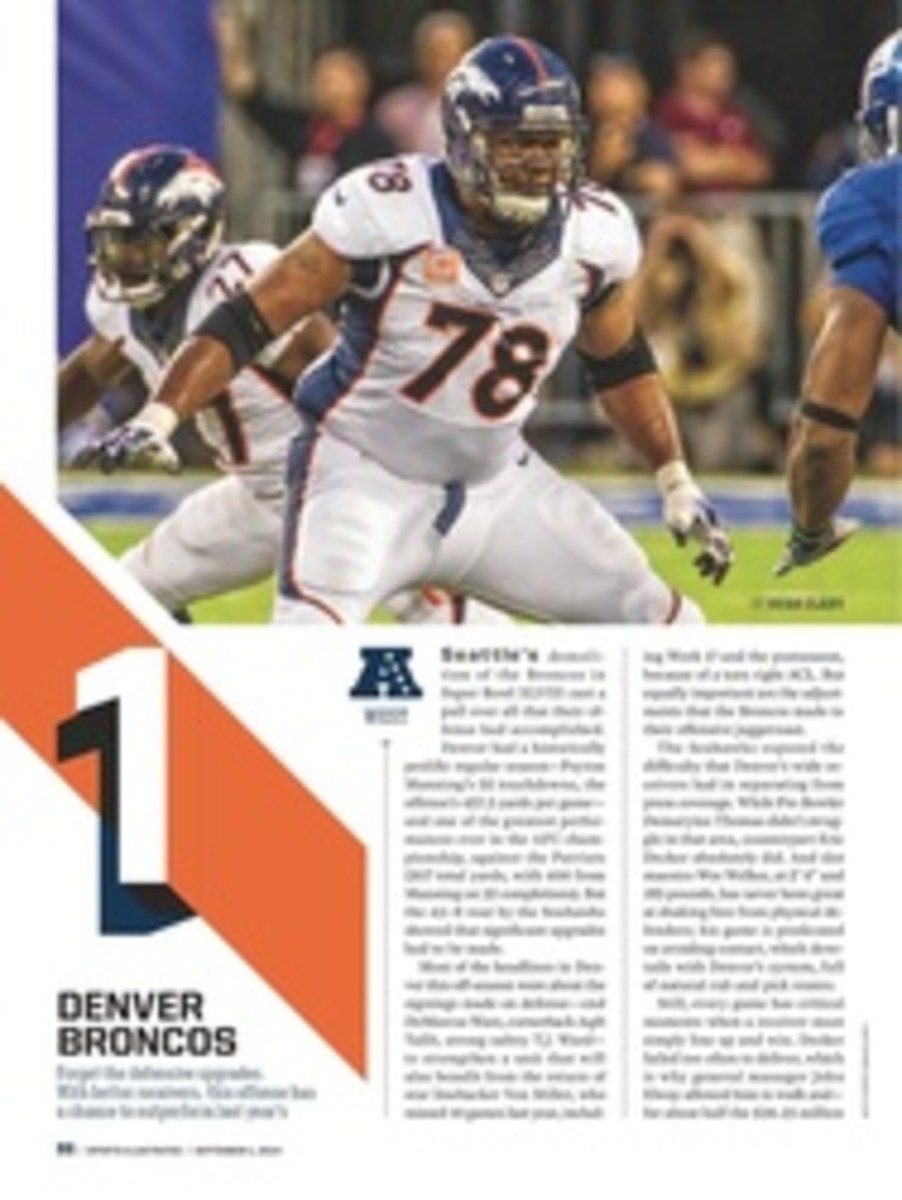
3 ARIZONA CARDINALS
Some defensive coordinators use disguised looks and pressures to hide a weakness, but for Todd Bowles, who's in his second season running the D in Arizona, deception is simply a preferred style of play.
This year, though Bowles has two new weak spots to consider: defensive end, where hard-charging veteran Darnell Dockett is out for the season with a torn ACL, and inside linebacker, where Daryl Washington drew a yearlong suspension for violating the league's substance-abuse policy. (Washington in the off-season also pleaded guilty to assaulting the mother of his child, so there's no promise he'll be back next season either.)
Fortunately, Bowles has stars remaining in his 3--4 defense. Up front, long-armed seventh-year veteran Calais Campbell is a monster, although he'll receive more attention from blockers with Dockett out. On the back end, All-Pro Patrick Peterson might be the best pure man-to-man corner in the league. He rarely requires safety help, giving the rest of the stellar secondary a chance to be spectacular. At cornerback opposite Peterson will be lanky veteran Antonio Cromartie, who was signed to a one-year deal. Then there's safety Tyrann Mathieu, who was recently activated from the PUP list and could be back in September from the torn ACL and LCL he suffered last December. The Honey Badger may have the best combination of quickness, versatility and instincts of any defensive back to enter the league in the last dozen years.
Bowles deploys this talent in an array of aggressive and creative pressure packages. He's seeking quarterback sacks, of course, but schemes like this are about much more. By bringing pressure—or simply by threatening it—a defense can force the offense to play faster than it wants to, making it more likely to abandon a play's structure and rush decisions. This leads to incompletions, sacks or, ideally, turnovers. All of them will get an offense off the field quickly, which is the essence of good defense.
While most pressure designs require man coverage, the Cardinals may feel inclined to use more zone coverage this season for the sake of variety, though Cromartie's adeptness in man-to-man and Peterson's excellence as a shutdown press corner doesn't make it essential. (Both Peterson and Cromartie are unrefined in zone coverage anyway.) When Mathieu returns, he'll play free safety in the base 3--4 alongside either Tony Jefferson or intimidating first-round rookie strong safety Deone Bucannon out of Washington State. In the nickel, Mathieu will slide down into the slot, where he's a dangerous blitzer and is effective playing trail-technique man coverage with help over the top.
Confidence in the secondary is somewhat offset by concerns at linebacker. On the inside, untested Kevin Minter, a second-round pick in 2013, is joining 13-year veteran Larry Foote, who is coming off a ruptured biceps that wiped out most of his '13 season. They are replacing absent stars Washington and Karlos Dansby (who left for the Browns as a free agent). Talent is also thin on the outside, except for 36-year-old weakside edge rusher John Abraham, who surprised with 11½ sacks last year.
When the Cardinals have the ball they will be under the guidance of coach Bruce Arians, one of the NFL's best passing-game architects. Arians also has weak areas to account for, especially on the offensive line, which was inadequate a year ago. Though Arizona should improve on the left side with long-armed free-agent pickup Jared Veldheer at tackle and 2013 first-round pick Jonathan Cooper, who is back from a season-ending broken left leg, at guard, the Cardinals' front five still has problems. Center Lyle Sendlein, an eight-year veteran, lacks strength, and the right-side starters Paul Fanaika and Bobby Massie lack athleticism. This puts added pressure (often literally) on quarterback Carson Palmer who, entering his 12th season, is smart but still too hit-or-miss.
But like Bowles, Arians does have his playmakers—namely future Hall of Fame receiver Larry Fitzgerald and future star running back Andre Ellington. These players will only flourish if Arians maintains his high level of schematic diversity.
Diversity will define both offense and defense for a Cardinals team that could be better than it was a year ago, when it went 10--6. But it still has the daunting task of overcoming powerhouse division rivals San Francisco and Seattle. No amount of diversity will make that happen.
2014 SCHEDULE
2013 Record: 10--6
WEEK 1
SD MON [HOME]
NYG [AWAY]
SF [HOME]
BYE
DEN [AWAY]
WAS [HOME]
OAK [AWAY]
PHI [HOME]
DAL [AWAY]
STL [HOME]
DET [HOME]
SEA [AWAY]
ATL [AWAY]
KC [HOME]
STL THUR [AWAY]
SEA [HOME]
SF [AWAY]
WEEK 17
FOCUS ON
The passing game
In year 10, Larry Fitzgerald is still the Cardinals' scariest weapon—and coach Bruce Arians knows it. That's why upon taking over in 2013, he made the superstar the "Z" receiver in his scheme. This means that instead of aligning in a stagnant stance on the line of scrimmage as he used to do, the eight-time Pro Bowler now operates on the move and from a variety of locations, usually tight to the formation. It's the same role Arians cast Hines Ward and Reggie Wayne in when he directed the offenses in Pittsburgh and Indianapolis. By moving Fitzgerald, Arians can more readily build route combinations around him, knowing that other receivers, such as Michael Floyd and 2014 third-rounder John Brown out of Pittsburg (Kans.) State won't be the defense's focus. Last season Floyd, a first-round pick in '12, emerged as a deep-intermediate threat in this system, catching 65 balls for 1,041 yards. Much of that production can be attributed to the attention defenses paid to Fitzgerald, who still had 82 catches for 954 yards.
THE CASE FOR
Running back Andre Ellington
When Rashard Mendenhall walked away from football after the 2013 season at age 26, Arizona's running back duties fell to Ellington—who might well have taken over even if Mendenhall had stayed. Ellington, a sixth-round pick last year who averaged a league-best 5.5 yards on 118 carries, showed sparkling potential as a multifaceted weapon out of the backfield and as a receiver in the slot or out wide. He has great control of his quickness and stop-start maneuvers, can turn to the perimeter on a dime and has lateral agility that can embarrass even the soundest of tacklers. Capping these talents with breakaway speed, Ellington gives an otherwise bland Cardinals rushing attack home run potential. That said, Ellington's receiving abilities could prove more valuable to an offense that, under passing-game aficionado Bruce Arians, frequently shifts into empty backfield sets. Ellington is a deft enough route runner to win one-on-one matchups against cornerbacks, much less safeties or linebackers. He can be the ultimate chess piece in a system predicated on creating matchup problems.
PHOTO
CHRIS O'MEARA/AP
CB PATRICK PETERSON
PHOTO
SAM GREENWOOD/GETTY IMAGES
NINTEEN PHOTOS

